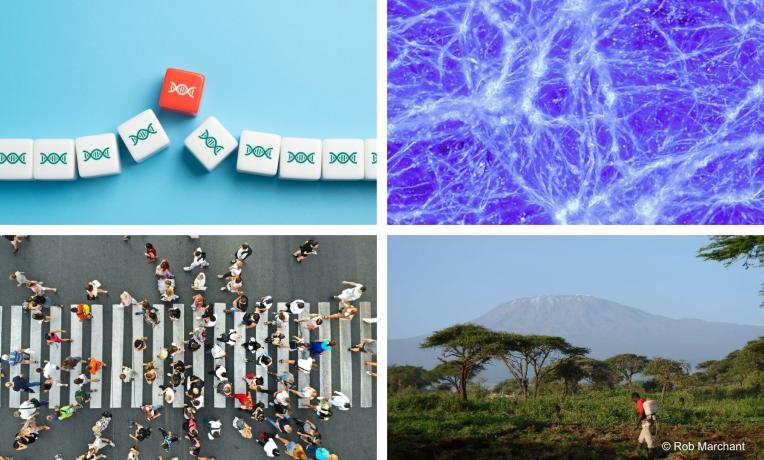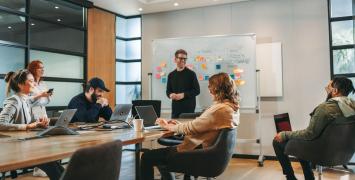Synergy Grants 2025: Examples of projects

Innovative tools to treat genetic disorders
Millions of people worldwide are affected by genetic diseases, which can result from specific gene mutations or broader genetic disruptions. One type of mutation, known as a premature termination codon (PTC), causes early termination of protein synthesis of essential human genes, leading to truncated, non-functional proteins. PTCs are responsible for approximately 11% of genetic diseases.
A team of four researchers - Leoš Valášek, Julius Lukeš, Olivier Namy and Mark Osborn - will address the important scientific challenge of treating PTCs. They will first investigate how alternative genetic decoding works in single-celled organisms called protists. Building on this knowledge, they will then engineer specific tools - small RNA molecules called tRNAs, which are essential for protein synthesis, and specific compounds known as readthrough-inducing drugs (TRIDs) - that can bypass genetic errors. These tools will then be tested in cells and in vivo models of severe genetic diseases affecting children. By correcting the genetic flaws, these tools might help restore normal function of cells and, in the long term, potentially lead to the development of a small number of specific drugs that can be used to broadly treat numerous genetic disorders.
The planned research requires a unique combination of skills and expertise across various disciplines, including protist biology, tRNA biology, protein synthesis, disease pathology, gene therapy, and drug development. The four scientists are world-leading experts in their fields, and their close collaboration promises to produce major advances in basic science with direct and broad therapeutic potential.
Leoš Valášek is Principal Investigator at the Institute of Microbiology at the Czech Academy of Sciences, in Czech Republic. Also based at the Czech Academy of Sciences, Julius Lukeš is Principal Investigator at the Biology Centre. Olivier Namy is Principal Investigator and Research Director at the Institute for Integrative Biology of the Cell at the Université Paris-Saclay, CEA, CNRS in France. Based in the US, Mark Osborn, Principal Investigator at the University of Minnesota, focusses on gene and cell therapy for inherited and acquired paediatric genetic diseases.

Project: 3Stops2Go - Three stop codons to get over to flourish
Researchers:
- Leoš Valášek, Institute of Microbiology, Czech Academy of Sciences, Czech Republic
- Julius Lukeš, Biology Centre, Czech Academy of Sciences, Czech Republic
- Olivier Namy, Université Paris-Saclay, CEA, CNRS, France
- Mark Osborn, University of Minnesota, USA
ERC funding: €9.755.098 million over 72 months
Exploring the first microseconds of the Universe with magnetic field
To understand how the Universe was formed and how it has changed over time, scientists study the formation of the first elements, the radiation left over from the Big Bang, and the large-scale structure of galaxies. However, the very first microseconds after the Big Bang cannot be studied directly, because no radiation from that time has survived. Yet, those first instants hold the key to understanding some of the most fundamental physical processes such as how the Universe became hot and uniform, how the forces of nature split apart, and how matter, antimatter, and dark matter first appeared.
Four leading scientists – Andrii Neronov, Franco Vazza, Chiara Caprini, and Axel Brandenburg – are joining forces to uncover what happened during those first crucial instants of the Universe’s evolution. Their combined expertise spans from cosmic microwave and gravitational wave signals to gamma rays, cosmic rays, the magnetic dynamics of the Universe, and radio astronomy.
The researchers aim to develop a new way to shed light on the Universe’s first microseconds using cosmological magnetic fields. These fields can carry information about physical processes that took place right after the Big Bang. The scientific team will combine data from various types of observations - including radio, gamma rays, and gravitational waves - with advanced simulations, to link today’s cosmic magnetic fields to the physical processes that created them in the first moments of the Universe.
Andrii Neronov is a professor of astrophysics at the University Paris Cité and a researcher at École Polytechnique Fédérale de Lausanne. Franco Vazza is a professor of astrophysics at the University of Bologna. Chiara Caprini, a researcher at CERN & professor at the University of Geneva, works in the field of theoretical cosmology. Axel Brandenburg is a professor of astrophysics at Nordita within the University of Stockholm, specializing in astrophysical fluid dynamics.

Project: COSMOMAG - Probe of the first microseconds of the Universe with cosmological magnetic fields
Researchers:
- Andrii Neronov, University of Paris Cité, France
- Franco Vazza, University of Bologna, Italy
- Chiara Caprini, CERN, Switzerland
- Alex Brandenburg, University of Stockholm, Sweden
ERC funding: €9.962.435 million over 72 months
Physics and psychology in motion: Understanding crowd movement
From festivals to busy train stations, modern societies continue to bring people together in dynamic crowds. Although researchers have attempted to unravel the mysteries of human movement in groups for over a century, it remains a scientific puzzle. We understand that crowds can shift rapidly between behaviours such as walking, queuing or overtaking. However, current models struggle to capture the complex interplay between physical and socio-psychological factors inherent in crowd movement.
In an innovative approach to bridge the divide between social and physical sciences, three leading researchers – Anna Sieben, Tom Postmes and Armin Seyfried – have teamed up to integrate the physics of the crowd (such as spatial structures, speed and flow) with the social psychology of crowd members, considering their intentions, social norms, and understanding of the situation.
The team will combine cutting-edge physical modelling and the psychological, first-person perspective of crowd participants, including insights from mime and choreography experts. This unique strategy will ultimately enable them to develop a novel “Social Agent Model” to mimic and predict crowd movements. The project thus serves as a springboard for improving safety procedures and solving other puzzling transitions in mass behaviour, e.g. on financial markets, social media or in politics.
Anna Sieben is a professor of social psychology at the University of Wuppertal and Head of Division at the Institute for Advanced Simulation (IAS-7), Forschungszentrum Jülich (FZJ) in Germany. Tom Postmes, also a professor of social psychology, chairs the corresponding department at the University of Groningen in the Netherlands. Armin Seyfried is a physicist, professor at the University of Wuppertal and Director of the Institute for Advanced Simulation (IAS-7) at FZJ.

Project: CrowdING - Integrating the physics and social-psychology of crowd movement
Researchers:
- Anna Sieben, Forschungszentrum Jülich GmbH, Germany
- Tom Postmes, University of Groningen, Netherlands
- Armin Seyfried, Forschungszentrum Jülich GmbH, Germany
ERC funding: €9.379.840 million over 72 months
How our relationship with mountains shapes the future
Changing climates, growing populations, biodiversity threats and agricultural transformations put our mountains under pressure. These challenges impact not only local communities and the surrounding lowlands but have global impacts too, since mountains are often hotspots of biodiversity and act as carbon sinks. With the increased interconnection between human systems and ecosystems comes the question of how nature and societies will keep interacting in and beyond so-called mountain socioecological systems.
An interdisciplinary team of researchers focusses on nine East African mountain settings to illustrate pathways for sustainable futures. To achieve this, they look at the principal services provided by mountain ecosystems (food, energy and water) and biocultural diversity, on the one hand. On the other hand, they investigate how societies exploit, co-exist with, or enhance nature. Observations from these dynamics in the past and present, will guide their predictions for the future to support mountain socioecological systems worldwide in navigating future opportunities and challenges.
The research team includes four experts from the UK, South Africa, Spain, and Germany; embedded with partners from Kenya, Tanzania and Uganda. Rob Marchant, professor of tropical ecology at the University of York, has a research focus on ecosystems and how they change. Laura Pereira is a professor in sustainability transformations and futures at the Global Change Institute from the University of Witwatersrand Johannesburg. Professor Unai Pascual is an ecological economist at the Basque Centre for Climate Change, and Thomas Hickler is a professor of biogeography at the Senckenberg Institute.

Project: AFRI-CAN - East African Mountain social ecological dynamics
Researchers:
- Rob Marchant, University of York, UK
- Laura Pereira, University of Witwatersrand Johannesburg, South Africa
- Unai Pascual, Basque Centre for Climate Change, Spain
- Thomas Hickler, Senckenberg Institute, Germany
ERC funding: €9.988.220 million over 72 months
NB: Figures are tentative and depend on the signing of the grant agreements





